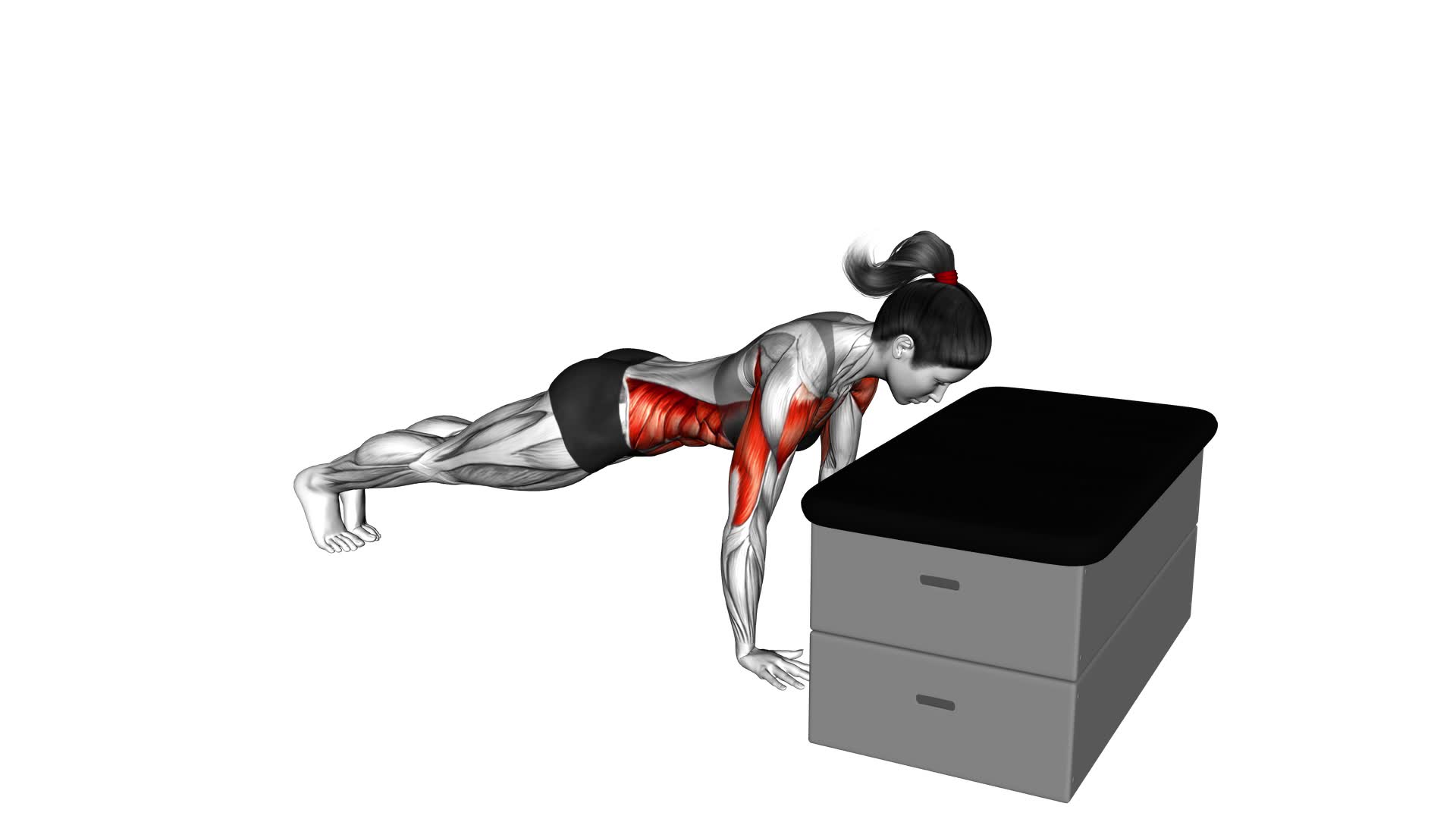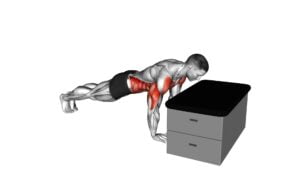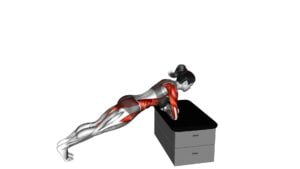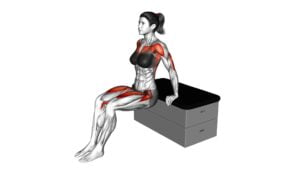Climber a Padded Stool Supported (Female) – Video Exercise Guide & Tips

Get ready to elevate your workout with the Climber a Padded Stool Supported exercise! This video exercise guide and tips will help you learn the proper technique, avoid common mistakes, and increase intensity.
Watch This Exercise Video
With modifications and variations available, you can personalize the workout to fit your fitness level. Stay safe by following the safety precautions and considerations provided.
It's time to conquer new heights in your fitness journey!
Key Takeaways
- Increased core strength
- Improved balance
- Engages core muscles for stability
- Targets abdominal muscles, obliques, and lower back
Benefits of the Climber a Padded Stool Supported Exercise
You can experience increased core strength and improved balance through the benefits of the Climber a Padded Stool Supported exercise. This exercise provides stability benefits by engaging your core muscles, which are responsible for maintaining your body's balance and stability. By using a padded stool as support, you can focus on engaging your core without the risk of losing your balance.
The Climber exercise specifically targets your abdominal muscles, obliques, and lower back, all of which contribute to a strong and stable core. As you perform the exercise, you'll feel your core muscles working to support your body's movement and maintain proper form. This engagement not only strengthens your core but also enhances your overall stability and balance, allowing you to perform daily activities with ease and confidence.
In addition to core engagement and stability benefits, the Climber a Padded Stool Supported exercise also helps to improve coordination and body control. The controlled movements required in this exercise challenge your proprioceptive system, which is responsible for spatial awareness and movement control. By practicing this exercise regularly, you can enhance your ability to coordinate movements and maintain control over your body.
With its focus on core engagement, stability benefits, and improved balance, the Climber a Padded Stool Supported exercise is an effective way to strengthen your core muscles and enhance your overall stability. Now, let's explore the proper technique for this exercise to ensure maximum effectiveness and safety.
Proper Technique for the Climber a Padded Stool Supported Exercise
To perform the Climber a Padded Stool Supported exercise correctly, start by positioning yourself on the padded stool. Here's how to execute the exercise with proper form:
- Place the padded stool against a wall or other sturdy surface to prevent it from sliding.
- Sit on the stool with your back straight and your feet flat on the floor.
- Lean back slightly, engaging your core muscles to maintain stability.
- Lift your feet off the ground and bring your knees towards your chest, one at a time.
- As you bring one knee towards your chest, extend the other leg straight out in front of you.
- Alternate between legs, mimicking a climbing motion.
- Keep your movements controlled and avoid swinging your legs.
- Breathe regularly throughout the exercise to maintain proper oxygen flow to your muscles.
- Start with a slow pace and gradually increase your speed as you become more comfortable with the movement.
Proper form for the climber exercise is essential to maximize its benefits and minimize the risk of injury. By following these guidelines, you can ensure that you're performing the exercise correctly and effectively.
Incorporating variations into your climber exercise routine can also add variety and challenge to your workout. Some popular variations include:
- Mountain Climbers: Perform the exercise on the floor in a high plank position, alternating between bringing your knees towards your chest.
- Hanging Knee Raises: Hang from a pull-up bar and bring your knees towards your chest, engaging your core muscles to control the movement.
- Weighted Climbers: Hold a dumbbell or kettlebell in each hand while performing the exercise to increase the resistance and intensity.
Remember to listen to your body and modify the exercise as needed to accommodate your fitness level and any existing injuries or limitations.
Common Mistakes to Avoid During the Climber a Padded Stool Supported Exercise
Avoiding these common mistakes will help you perform the Climber a Padded Stool Supported exercise correctly and safely. It's important to be aware of these errors to maximize the effectiveness of your workout and prevent injuries.
One common mistake is using improper technique. Make sure to maintain a neutral spine throughout the exercise, avoiding any excessive arching or rounding of the back. This will help protect your lower back and maintain proper alignment.
Another mistake is rushing through the exercise. Remember to perform the movements in a controlled and deliberate manner, focusing on engaging your core and maintaining stability. Going too fast can compromise your form and reduce the effectiveness of the exercise.
Additionally, avoid putting too much weight on the padded stool. While the stool provides support, it shouldn't bear the entire weight of your body. Instead, focus on using your core muscles to lift your legs and engage your abdominal muscles.
Tips for Increasing Intensity and Progressing in the Climber a Padded Stool Supported Exercise
To increase the intensity and progress in the Climber a Padded Stool Supported exercise, incorporate advanced variations and challenge your core muscles further.
Here are some progression tips and ways to increase difficulty:
- Increase the speed: Once you have mastered the basic form, try performing the exercise at a faster pace. This will engage your muscles more and increase the intensity of the workout.
- Add weights: To further challenge your core muscles, you can hold a pair of dumbbells or wear a weighted vest while performing the exercise. This will add resistance and make the exercise more challenging.
- Increase the duration: Start by performing the exercise for a set amount of time, such as 30 seconds, and gradually increase the duration as you get stronger. This will help improve your endurance and overall fitness level.
By incorporating these progression tips, you can continue to challenge yourself and see improvements in your strength and fitness.
Now, let's move on to the next section where we'll discuss modifications and variations of the Climber a Padded Stool Supported exercise.
Modifications and Variations of the Climber a Padded Stool Supported Exercise
To modify the Climber a Padded Stool Supported exercise, you can start by using different stool heights to target different muscle groups and increase or decrease the difficulty.
You can also add weights to challenge your upper body and core strength further.
If you experience knee pain, you can try alternative exercises such as the standing mountain climber or the seated knee tucks to engage the same muscle groups without putting excessive stress on your knees.
Different Stool Heights
Adjusting the height of the stool is a great way to modify and vary the Climber a Padded Stool Supported exercise. Using adjustable stools allows you to customize the workout based on your fitness level and goals. Here are two ways you can adjust the stool height:
- Lower stool height: If you're just starting or looking for a modification, lower the stool height. This reduces the range of motion and decreases the difficulty of the exercise. It can help you focus on proper form and build strength gradually.
- Higher stool height: For a more challenging workout, raise the stool height. This increases the range of motion and engages your muscles more effectively. It adds intensity and allows you to push your limits, promoting muscle growth and endurance.
By adjusting the stool height, you can tailor the Climber a Padded Stool Supported exercise to your specific needs and abilities.
Now, let's explore another way to add challenge to this exercise by incorporating weights.
Adding Weights for Challenge
To add an extra challenge to the Climber a Padded Stool Supported exercise, you can incorporate weights. By adding resistance, you'll engage your muscles even more and increase the intensity of the workout.
Start by holding a dumbbell in each hand while performing the climber movement. The added weight will challenge your upper body strength and core stability.
As you progress, you can gradually increase the weight to further enhance the difficulty of the exercise. This advanced modification won't only help you build strength but also improve your overall fitness level.
Now that you know how to add weights to the Climber a Padded Stool Supported exercise, let's explore some alternatives for knee pain in the next section.
Alternatives for Knee Pain
If you're experiencing knee pain, try modifying the Climber a Padded Stool Supported exercise by using an alternative movement. Here are some alternative exercises that can help strengthen your knees:
- Step Ups: Step onto a low platform with one foot, then bring the other foot up to meet it. Step back down and repeat on the other side.
- Leg Press: Using a leg press machine, push the weight away from you using your legs. This exercise takes the pressure off your knees while still working the muscles.
These alternative exercises provide a lower impact on your knees while still targeting the same muscle groups. Remember to start with a weight or height that's comfortable for you and gradually increase as you build strength. By incorporating these modifications, you can still achieve a challenging workout without aggravating your knee pain.
Now, let's move on to the next section where we'll discuss the safety precautions and considerations for the Climber a Padded Stool Supported exercise.
Safety Precautions and Considerations for the Climber a Padded Stool Supported Exercise
Ensure your safety and avoid injury by following these important precautions and considerations for the Climber a Padded Stool Supported exercise.
Safety precautions are essential to prevent accidents and ensure a safe workout. Before starting the exercise, make sure the padded stool is stable and secure. Check for any loose parts or instability that could lead to falls or injuries. Additionally, it's important to use a stool that's appropriate for your weight and height to prevent any strain or damage.
Exercise modifications can be made to accommodate different fitness levels and abilities. If you're a beginner or have any existing medical conditions, it's recommended to consult with a healthcare professional before attempting this exercise. They can provide guidance on the proper technique and modifications that suit your specific needs.
When performing the Climber a Padded Stool Supported exercise, it's crucial to maintain proper form and technique. Keep your back straight, engage your core muscles, and avoid hunching or rounding your shoulders. This helps to prevent strain on your back and ensures proper alignment throughout the exercise.
Lastly, listen to your body and stop if you experience any pain or discomfort. Pushing through pain can lead to injuries, so it's important to listen to your body's signals and adjust or stop the exercise accordingly.
Frequently Asked Questions
How Many Calories Can Be Burned During the Climber a Padded Stool Supported Exercise?
During the climber a padded stool supported exercise, you can burn a significant number of calories.
This exercise helps with weight loss by engaging multiple muscle groups and increasing your heart rate.
The number of calories burned will depend on factors such as your weight, intensity level, and duration of the exercise.
It's an effective way to improve cardiovascular fitness and contribute to your overall calorie burn.
Can the Climber a Padded Stool Supported Exercise Help With Weight Loss?
Yes, the climber a padded stool supported exercise can help with weight loss. This exercise is a great way to engage your core and burn calories. By incorporating variations and modifications for different fitness levels, you can challenge yourself and continue to see progress.
The climber a padded stool supported exercise targets multiple muscle groups and increases your heart rate, making it an effective choice for weight loss. Stick with it and you'll start seeing results.
Can the Climber a Padded Stool Supported Exercise Be Done by Beginners?
Yes, the climber a padded stool supported exercise can be done by beginners. By using a padded stool, you can modify the exercise to suit your fitness level.
This exercise offers several benefits for beginners, such as improving core strength, increasing cardiovascular endurance, and enhancing coordination. The stool provides stability and support, allowing you to focus on proper form and technique.
Incorporating this exercise into your routine can help you progress and build a solid foundation for more advanced movements.
How Often Should the Climber a Padded Stool Supported Exercise Be Performed?
To determine the frequency of the climber a padded stool supported exercise, consider your fitness level and goals.
Beginners can start with 2-3 sessions per week, gradually increasing as you get stronger.
If you're more advanced, aim for 3-4 sessions per week.
Remember to listen to your body and take rest days as needed.
To modify the exercise, you can decrease or increase the height of the stool or adjust the speed and intensity of the movement.
Can the Climber a Padded Stool Supported Exercise Help Improve Core Strength?
The climber is a padded stool supported exercise that can definitely help improve your core strength. By engaging your abdominal muscles, this exercise helps to stabilize your body and improve balance.
It's a versatile exercise that can be modified to suit different fitness levels. Whether you're a beginner or more advanced, you can adjust the intensity and difficulty of the exercise to challenge yourself and continue progressing towards your fitness goals.
Conclusion
In conclusion, the Climber a Padded Stool Supported exercise offers numerous benefits for individuals looking to improve their overall fitness. By following proper technique and avoiding common mistakes, one can maximize the effectiveness of this exercise.
Additionally, tips for increasing intensity and modifications/variations allow for progression and customization based on individual needs. It's important to prioritize safety precautions and considerations to prevent any potential injuries.
Incorporating the Climber a Padded Stool Supported exercise into your workout routine can help enhance strength, stability, and endurance.

Author
Years ago, the spark of my life’s passion ignited in my mind the moment I stepped into the local gym for the first time. The inaugural bead of perspiration, the initial endeavor, the very first surge of endorphins, and a sense of pride that washed over me post-workout marked the beginning of my deep-seated interest in strength sports, fitness, and sports nutrition. This very curiosity blossomed rapidly into a profound fascination, propelling me to earn a Master’s degree in Physical Education from the Academy of Physical Education in Krakow, followed by a Sports Manager diploma from the Jagiellonian University. My journey of growth led me to gain more specialized qualifications, such as being a certified personal trainer with a focus on sports dietetics, a lifeguard, and an instructor for wellness and corrective gymnastics. Theoretical knowledge paired seamlessly with practical experience, reinforcing my belief that the transformation of individuals under my guidance was also a reflection of my personal growth. This belief holds true even today. Each day, I strive to push the boundaries and explore new realms. These realms gently elevate me to greater heights. The unique combination of passion for my field and the continuous quest for growth fuels my drive to break new ground.







